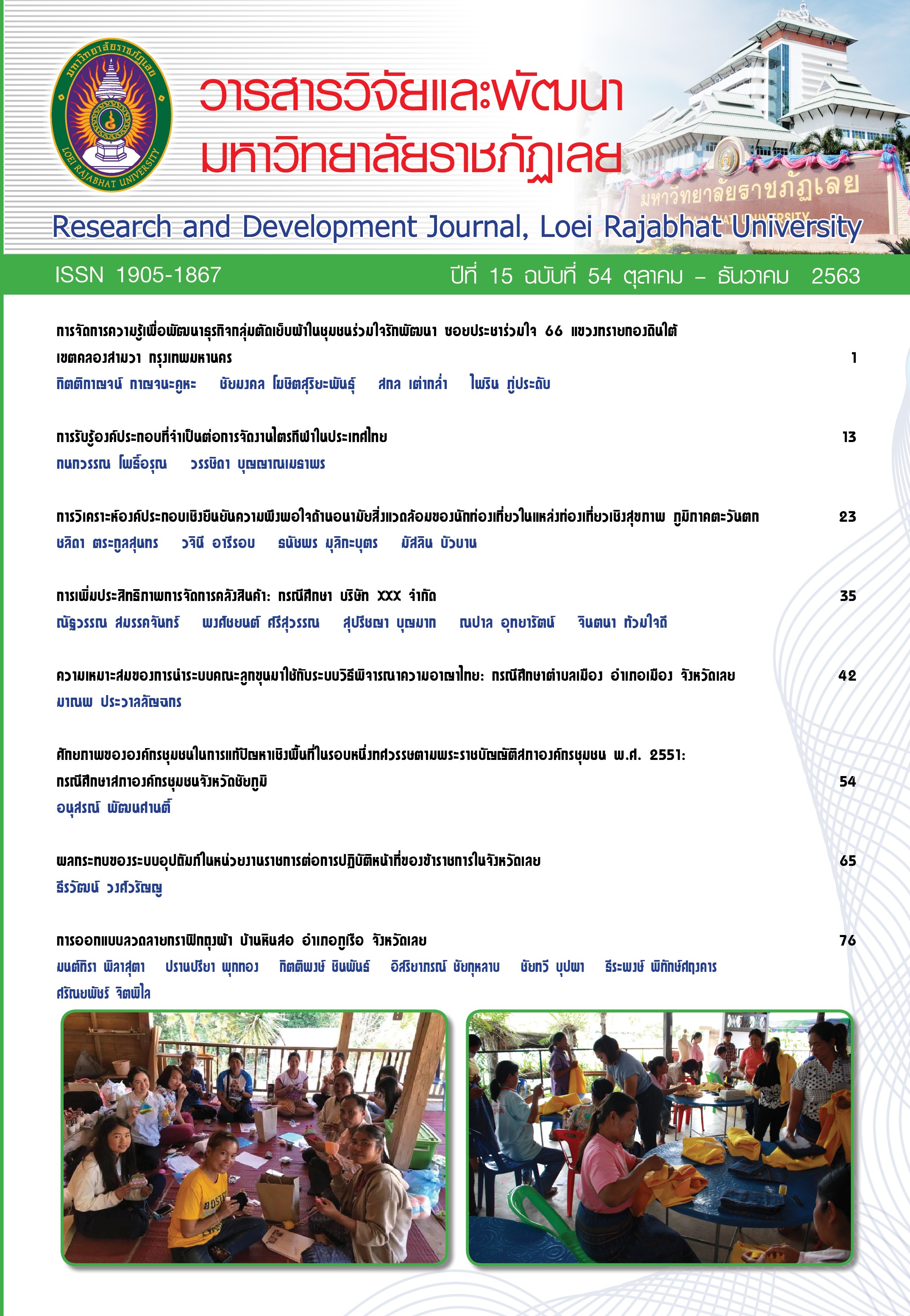Confirmatory Factor Analysis Environmental Health Satisfaction of Tourists in Health Tourism Destinations in Western Thailand
Keywords:
health tourism, environmental health, factors affecting environmental healthAbstract
The objectives of this research are 1) confirmatory factor analysis environmental health factors satisfaction of tourists in health tourism destinations Western Thailand. 2) to study the factor loading of tourist satisfaction with the management of environmental health factors. Collecting data through surveys of 358 tourists was analyzed by confirmatory factor analysis using the LISREL program.
Research results show that.
1. Measurement models for environmental health factors satisfaction of tourists in health tourism destinations Western Thailand correspond with empirical data.
2. Management satisfaction questions can be used to measure satisfaction in environmental health factors. In food hygiene factor (A), the highest factor loading is animals and insect prevention. Water cleanliness such as washing hands and water in the bathroom is the highest factor loading for drinking water supply factor (B). In waste management factor (C), the highest factor loading is the sufficiency of the waste dump. Toilet cleanliness is the highest factor loading for the management of toilets factor (D). In wastewater elimination factor (E), the highest factor loading is no water in the bathroom toilet area. Tourist information center and facilitator is the highest factor loading for safety factor (F).
References
กนก บุญศักดิ์, สิทธิชัย พรหมสุวรรณ, เสรี วงษ์มณฑา และวาสนา กีรติจำเริญ. (2561). อิทธิพลของปัจจัยที่มีต่อความภักดีของนักท่องเที่ยวต่อการท่องเที่ยวบนฐานชุมชนภาคตะวันออก เฉียงเหนือตอนล่างของประเทศไทย. NRRU Community Research Journal, 12(1), 10-28.
กรมการท่องเที่ยว กระทรวงการท่องเที่ยวและกีฬา. (2558). ยุทธศาสตร์การท่องเที่ยวไทยปี 2558-2560. กรุงเทพฯ: กระทรวงการท่องเที่ยวและกีฬา.
การท่องเที่ยวแห่งประเทศไทย. (2555, 29 สิงหาคม). ความสำคัญของการบริหารจัดการการท่องเที่ยวอย่างยั่งยืน. สืบค้นจาก https://www.etatjournal.com/web/menu-read-web-etatjournal/menu-2012/menu-2012-apr-jun/449-22555-travel
เกษมสันต์ พิพัฒน์ศิริศักดิ์. (2551). การจัดการทางการตลาด. กรุงเทพฯ: มหาวิทยาลัยกรุงเทพ.
คมสิทธิ์ เทียนวัฒนา, สุจิตรา สุคนธทรัพย์ และวิภาวดี ลี้มิ่งสวัสดิ์. (2561). สถานการณ์ ความต้องการ และแนวโน้มของรูปแบบการท่องเที่ยวเชิงสุขภาพในประเทศไทย. วารสารวิชาการ สถาบันการพลศึกษา, 10(1), 168-177.
จินต์จุฑา แสงเพชร. (2550). การจัดการอนามัยสิ่งแวดล้อมของแหล่งท่องเที่ยวในจังหวัดชัยภูมิ. วารสารวิจัยสาธารณสุขศาสตร์ มหาวิทยาลัยขอนแก่น, 3, 87-96.
ดนัย เทียนพุฒ. (2543). การบริหารทรัพยากรบุคคลในทศวรรษหน้า. กรุงเทพฯ: จุฬาลงกรณ์มหาวิทยาลัย.
ดนัย บวรเกียรติกุล. (2561). งานอนามัยสิ่งแวดล้อมกับการท่องเที่ยว. วารสารการบริการและการท่องเที่ยวไทย, 13(1), 81-92.
ปุระชัย เปี่ยมสมบูรณ์ และสมชาติ สว่างเนตร. (2535). การวิเคราะห์เส้นโยงด้วยลิสเรล: สถิติสำหรับนักวิจัยทางวิทยาศาสตร์สังคมและพฤติกรรม. กรุงเทพฯ: สถาบันบัณฑิตพัฒนบริหารศาสตร์.
ผู้จัดการออนไลน์. (2562, 25 พฤศจิกายน). Wellness Tourism ยุทธศาสตร์ใหม่การท่องเที่ยว. สืบค้นจาก https://gotomanager.com/content/wellness-tourism-ยุทธศาสตร์ใหม่การท่องเที่ยว.
พูลพงศ์ สุขสว่าง. (2561). โมเดลสมการโครงสร้าง (พิมพ์ครั้งที่ 2). ชลบุรี: เอ.พี.บลูปรินท์.
ศุภชัย ปิดตานัง. (2555). รูปแบบการดำเนินงานสุขาภิบาลร้านอาหาร โดยกระบวนการมีส่วนร่วมสู่มาตรฐาน อาหารสะอาดรสชาติอร่อย. วารสารราชพฤกษ์, 10 (1), 65-70.
ศูนย์วิจัยกสิกรไทย. (2555, 29 สิงหาคม). การท่องเที่ยวเชิงสุขภาพอาเซียนปี 55. สืบค้นจาก https://millionaire-academy.com
ศูนย์วิจัยกสิกรไทย. (2562, 25 พฤศจิกายน). จับชีพจรนักท่องเที่ยวต่างชาติ ปี 62. สืบค้นจาก https://www.kasikornbank.com/th/business/sme/KSMEKnowledge/article/KSMEAnalysis/Documents/SMEAnalysis_Jan.pdf.
สำนักงานปลัดกระทรวงการท่องเที่ยวและกีฬา. (2562). สถานการณ์การท่องเที่ยวไทยที่สำคัญ. รายงานสภาวะเศรษฐกิจการท่องเที่ยว TOURISM ECONOMIC REVIEW, (1), 12-21.
สุชาติ ประสิทธิ์รัฐสินธุ์, กรรณิการ์ สุขเกษม, โศภิต ผ่องเสรี, และถนอมรัตน์ ประสิทธิเมตต์. (2549). แบบจำลองสมการโครงสร้าง: การใช้โปรแกรม LISREL, PRELIS และ SIMPLIS. กรุงเทพฯ: สามลดา.
สุภมาส อังศุโชติ, สมถวิล วิจิตรวรรณา และรัชนีกูล ภิญโญภานุวัฒน์. (2552). สถิติวิเคราะห์สำหรับการวิจัยทางสังคมศาสตร์และพฤติกรรมศาสตร์: เทคนิคการใช้โปรแกรม LISREL (พิมพ์ครั้งที่ 2). กรุงเทพฯ: เจริญดีมั่งคงการพิมพ์.
อริศรา ห้องทรัพย์. (2557). แนวทางการจัดการท่องเที่ยวเชิงสุขภาพแหล่งน้ำพุร้อนในภูมิภาคทางตอนเหนือของประเทศไทย (วิทยานิพนธ์ปริญญาวิทยาศาสตรมหาบัณฑิต). จุฬาลงกรณ์มหาวิทยาลัย, กรุงเทพฯ.
Alegre, J., & Magdalena, C. (2006). Destination loyalty: consumers’ economic behavior. Annals of Tourism Research, 33(3), 684-706.
Cochran, W. G. (1977). Sampling Techniques (3rd ed.). New York: Wiley.
Craggs, R., & Schofield, P. (2011). The Quays in Salford: an analysis of visitor perceptions, satisfaction and behavioral intention. International Journal of Tourism Research, 13, 583-599.
Hair, J. F., Jr., Black, W. C., Babin, BmJ., & Anderson, R. E. (2014). Multivariate data analysis: a global perspective (7th ed.). New Jersey: Prentice-Hall.
Hall, C. M. (1992). Adventure, sport and health tourism. Special interest tourism, 8(2), 141-158.
Knight, G. A., & Cavusgil, S.T. (2004). Innovation, Organizational Capabilities, and the Born Global Firm. Journal of International Business Studies, 3(5), 124-141
Lee, C. K., Yoon, Y. S., & Lee, S. K. (2007). Investigating the relationships among perceived value, satisfaction, and recommendations: The case of the Korean DMZ. Tourism Management, 28(1), 204-214
Mangold, G., & Miller, F. (1999). Word-of-mouth communications in the service marketplace. Journal of Service Marketing, 13(1), 73-90
Maslow, A. (1970). Motivation and personality. New York: Harper & Row
Smith, M., & Puczko, L. (2009). Health and Wellness Tourism. USA: Elsevier.
Schumacker, R. E., & Lomax, R. G. (2016). A beginner’s guide to structural equation modeling (4th ed.). New Jersey: Lawrence Erlbaum Associate.
Downloads
Published
How to Cite
Issue
Section
License
ข้อความที่ปรากฎในวารสารฉบับนี้เป็นความคิดเห็นของผู้เขียนแต่ละท่าน สถาบันวิจัยและพัฒนา มหาวิทยาลัยราชภัฏเลย และกองบรรณาธิการ ไม่จำเป็นต้องเห็นด้วยและไม่มีส่วนรับผิดชอบใดๆ
สถาบันวิจัยและพัฒนา มหาวิทยาลัยราชภัฏเลย ขอให้ผู้อ่านอ้างอิงในกรณีที่ท่านคัดลอกเนื้อหาบทความในวารสารฉบับนี้






